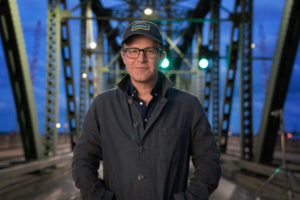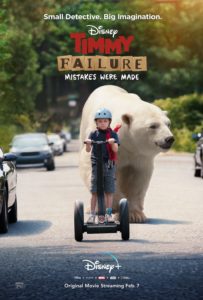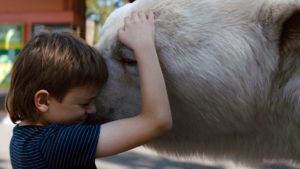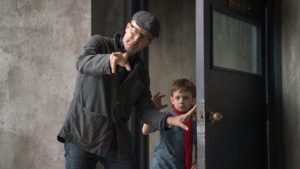Sundance 2020 Interview with “Timmy Failure: Mistakes Were Made” Director Tom McCarthy
Written by: Christopher Llewellyn Reed | January 30th, 2020

In the middle of the 2020 Sundance Film Festival, I had the opportunity to speak with director Tom McCarthy (Spotlight), by phone, to discuss his latest feature, Timmy Failure: Mistakes Were Made, which premiered at the fest (and which I also reviewed). The film is an adaptation of the first book in author Stephan Pastis’ best-selling series, and tells the story of eccentric 10-year-old Timmy Failure, his detective business, and his imaginary friend, a polar bear named Total. Here is a condensed digest of our conversation, edited for length and clarity.

Christopher Llewellyn Reed:How did this project start? Did you read the books and then decide you wanted to adapt? Or were you first approached by Disney?
Tom McCarthy: I had had a conversation with Sean Bailey, who heads up Disney production, years ago, and Sean, who liked the movies that I made, said, “Look, if you ever have anything that you think is appropriate for us and fits in the Disney family, we’d love to make a movie with you. We’re trying to constantly expand the movies we make and our brand.” He was just very sincere about it. And I said, “All right, but I don’t have anything now.” A number of years later, a colleague I was working with put the Timmy Failurebook on my desk, and was just like, “Hey, take a look at this.”
Finally, one day, I picked it up and started to read it, and I just found it really funny. I loved the voice of the character, which was very unique. It turned out that Steph, the author, was in town for a book tour and so we met up for a coffee. I really liked him. We got along, and I said, “Hey man, this might be something I could bring to my friends at Disney if you want me to.” He jumped at it. He was like, “Great!”And so, that was the beginning of that.
I went back to Sean. I was like, “I think I actually do have a piece of IP [intellectual property]. Take a look at this book. It would be a tricky adaptation, but I like the rhythm of it. I like the tone of it, and it feels like it fits squarely in the Disney world, but it’s something a little bit new.” That’s how the conversation started. They have just proven to be great partners, unwavering and supportive, pushing it forward. It was a good collaboration.
CLR: Speaking of the tone of the books, since I haven’t read them, does all of that whimsy come from them directly or did you, yourself, add any special tone of your own?
TM: Well, keep in mind that I ended up writing the screenplay with the writer of the books and there were six of them at the time.
CLR: Right, that’s true.
TM: I did that because I wanted to really make sure that if I held on to anything, it was Timmy’s voice. I knew Steph would bring that, and he really did. It became clear to me, after working on it for a while, that it was a tricky adaptation, because the book is way more meandering and all over the place. So, the plot of the movie is not the plot of the first book. I really needed to figure out a way to kind of force a plot onto his style of writing and hold on to everything else, and in a way to actualize the flash-aways, and the drawings, and all those kinds of things.
That took some real thinking, and work, and time, and we kind of got there together. When we strayed from the book, we tried to come up with new elements that felt very true to the writing and sometimes built on what was already in the book. or came up with new examples of it. It was a very collaborative process. So, some of it’s in the book and some of it’s not, quite frankly.
CLR: Would fans of the entire series find plot elements from subsequent books in this film? Or is everything that’s different a product of the two of you working together on this film?
TM: That’s a great question. I think there are some new elements invented. God, I really have to refresh, because at the time I’d read all the books and so we were pulling, and I have lost track. I had said, “Oh, I love this.” And Steph would be like, “Oh, we made that up.” And I’m like, “Oh, really?” He was like, “Yeah, what about that?” So, I think it’s a little bit of both.I don’t think we ever stray very far from the nature of it. Crispin’s a very different character in the book, however. He’s very mean-spirited and he really doesn’t like Timmy. I just felt like I was tired of seeing those sort of abusive, mean boyfriends, that it felt cliché and not right to me. I liked that Timmy was more challenged by this guy because he’s actually a very sincere, nice guy.

CLR: Wow, that’s fascinating that his character is diametrically the opposite in the books, because he was really fun as this goofy, overly nice meter maid.
TM: Totally. We liked that Timmy didn’t like him because he saw him as an underachiever, being a meter maid, and it just made more sense to who Timmy was. But finding that character, it wasn’t just Steph and I, it was also Kyle Bornheimer. He’s a wonderful actor. We really had to get together and be like, “Who is this guy? How do we ground him?”We met a few people in Portland whom he was really reminiscent of, including our wonderful locations manager there, Roger, who’s a Portland native, and he just had that kind of slightly surfer, slightly hipster, slightly sincere dude: a nice guy. And it just felt right. But we had to really kind of find that.
Flo is another one. In the books, Flo is a man, and we decided we wanted to make Flo female. Then we ended up casting Caitlin Weierhauser out of Portland, who’s a terrific actress. She’s kind of become one of the fan favorites in the screenings here at Sundance, which have been going really well, and it’s really exciting to watch. But every time she opens her mouth, they laugh. So, there are changes like that along the way.
CLR: Speaking of the cast … they’re all great, but the movie really rests on the slim shoulders of your lead actor, the young Winslow Fegley. How did you find him?
TM: That was tricky. I started casting that role about eight or nine months before we even committed to doing the movie. I used Disney’s in-house casting at first and just sort of thought, “Start looking for this kid.” I knew I didn’t want to get into a position where we’re ready to shoot and we don’t have the kid because it was a really difficult role. We saw, I don’t know, 600 or 700 kids, I would have to guess. And really, Winslow came in sort of late in the game, and just at that point we knew. I knew exactly what I was looking for, and I was just sort of waiting for him to arrive, and he did.
His first take on the character was a little off, but he took direction remarkably well. We had to find a kid that felt like a kid, that had a unique, specific look to him, that could handle the language and could handle the attitude without being off-putting. I wanted this to be someone you could love and care for, who was also accessible. I didn’t want him to be too precocious and too annoying. So, there was a lot of balance in that. Winslow just really did a wonderful job of walking that line and being incredibly present with his logic, and his intention, and his consistency of character. Again, I credit Steph’s initial inception of Timmy. But ultimately, Winslow’s execution of that character is really something special.

CLR: I completely agree. Now, I tend to interview directors of smaller films. This is the first time I’ve had a chance to ask the following: you’ve got a CGI polar bear, Total, and I’m curious what it’s like to direct that kind of a character versus directing a live human. You’re working, obviously, with a team of animators, or at least one animator, or whatever special effects people you have. How do you find the emotion working with a team like that for a specific digital character?
TM: Well, I feel like what it really was about was refining the personality of the character first, right? It was sort of saying, “What is the personality of Total? What’s his relationship with Timmy?” Really making sure that we understood that. So by we, I mean the actors, my cinematographer, and my visual effects supervisor – Richard McBride – who was really terrific, and then really getting as specific as we could, so we knew in each moment exactly how that bear might react to any certain situation and how Timmy would react to him and interact in the moment with him. It’s an interesting character because he’s very aloof, he’s very independent, he’s very unreliable and he’s lazy. Why did Timmy invent Total? Only Timmy could answer.
What’s interesting about your question, though, and how you asked it, is I think this film owes a lot more to independent cinema than it does to classical Disney cinema, in terms of tone, structure, character and story. That’s my roots, right? My first movie was here at Sundance, The Station Agent. It was a half-million-dollar movie.So, when I was screening TimmyI was like, “Oh, the people who aren’t totally getting it, especially the sort of broader mainstream audiences, they haven’t really seen a lot of independent movies. They don’t know really what’s happening. They don’t know how to place this.” It really made me go back and kind of restructure one or two things at the beginning of the movie to really give them something to anchor and to really understand: what are the flash-aways? How are they going to operate? And what’s the relationship between the mother and son here? And just set it up a bit more. It was very subtle.
In fact, when I went to do the reshoots, Disney was like, “Why would you reshoot? The movie’s working great.” And I’m like, “Because I know now what I need to do. I need to sort of place this a little better for audiences who don’t have that exposure to this type of cinema. I think I can do that in very subtle ways and give them permission to lean into the movie as opposed to leaning back and trying to figure it out.” Because you do have to lean into this movie. It does ask a little bit of participation of you. So, I think that’s why I’m here.
It’s like, every little thing we did, it still felt like we were making a big independent movie. And, yeah, I had this bear, but there wasn’t really a bear. There was a guy in a gray suit sitting there with Timmy, and I had a VFX [visual effects] guy going, “That’s good. That’s all I need. That’s good. That’s all I need.” It was: 1) very intimate, and 2) very unintrusive. Because really, what makes Rich’s work so masterful in this is that you’re not dropping a digital effect into a VFX world. You’re dropping it into an incredibly real, incredibly specific world where it’s the only visual effect.You’re taking this 1500-pound polar bear and putting him in a little kitchen and a little house in Portland, or you’re putting him out walking through two cars outside a library. That level of specificity is tricky to pull off.

CLR: What I really like is that you did not anthropomorphize him, really. He more or less behaves like a bear, albeit a very specific bear. I thought that was really great.
TM: Well, look, that was the whole thing, right? I would even say we don’t do it at all. I would say, “Point to a moment where anyone thinks we did that and I would say, ‘Well, that’s exactly what my dog would do in that situation.’”
CLR: (laughs) Right.
TM: Maybe during the bank heist, because it’s the one time we see him in a sort of flash-away, right? So, that’s Timmy’s perception of Total. He does a few things there that maybe you would have trouble asking a dog to do. But the dog was always our North Star in trying to figure out that behavior.
CLR: All right, final question: Do you think there are going to be more Timmy Failurefilms, either by you or by someone else?
TM: I think it’s a positive sign that a lot of people have been asking us that here. Disney has already expressed interest in it. Full disclosure: I just came from a meeting with our producer Jim, and Stephan, who wrote the books, and Taylor, one of the other producers, about what “Timmy Two” would look like. Steph kind of wrote a first draft of what it could be, and we’ve started refining that.
So, my gut says yes, because I think it’d be really fun to keep exploring the characters, and the relationships, and build on them. And just judging by how the audience has been responding to the characters and screenings here, I think Disney’s feeling much more motivated. Sean and I talked about it about a year ago, but now I think they’re leaning into that idea. So, I would certainly be game in terms of my involvement. I don’t know how far I would go, but I would love to see it happen. I’d love to be a part of it in some way.

CLR: Well, I hope that it happens, and whether or not you’re a part of it, I look forward to whatever it is that you do next. Thank you so much for talking to me, Tom, and good luck with this movie.
TM: Yeah, nice chatting. Take care.
Film premieres February 7 on Disney+

